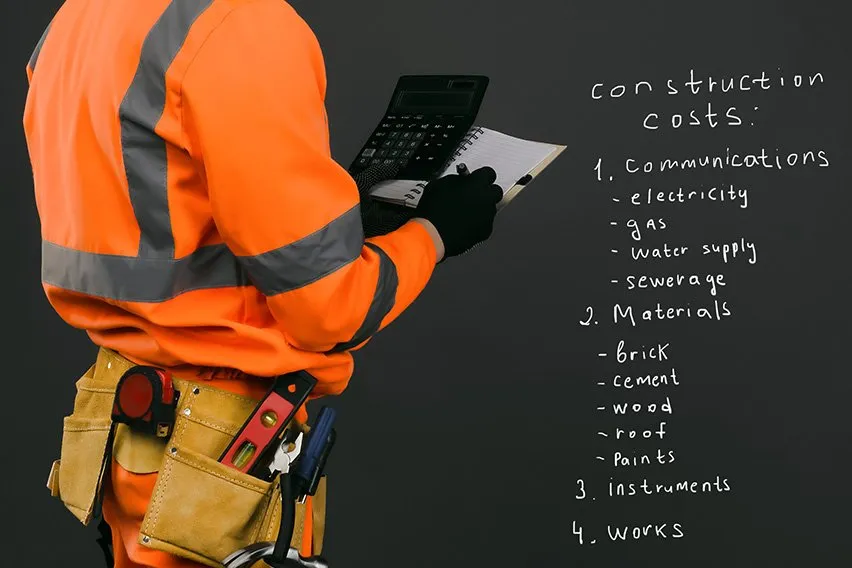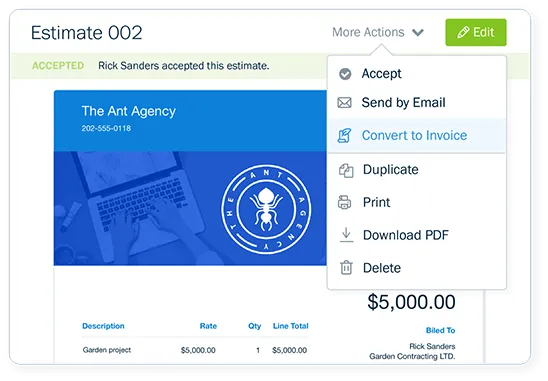How to Estimate Construction Jobs: 10 Steps

Have you ever had an initial conversation with a new construction client, and you weren’t sure how to answer their questions about the scope and cost of the work? If so, you’re not alone. While it takes time, experience, and knowledge to provide the right answers, nailing this piece of the puzzle is another way to ensure customer satisfaction.
If you want to start with a strong foundation, this guide will provide the definitions, tools, and skills you need to fine-tune your estimating abilities. We’re providing a step-by-step guide on how to estimate your construction jobs like a pro.
Key Takeaways
In this article, you’ll learn everything you need to know about the process of estimating construction projects. We’ll go over all the key elements, such as:
- Understanding what a construction estimate is
- The factors that influence your estimate for a construction project
- The importance of clarity and accuracy when estimating
- Tips for making your construction estimates as accurate as possible
- What happens after your estimate is sent
- How to access resources and online tools to make your estimates more accurate and efficient
Table of Contents
- What Is Construction Estimating?
- Factors That Influence Estimating Construction Jobs
- Why Accurate Estimates Are Important
- 10 Steps for Accurate Construction Job Estimation
- What to Do After Estimating a Job
- Conclusion
- Frequently Asked Questions
What Is Construction Estimating?
Construction estimating is the practice of getting an accurate idea of the total cost of any given construction project based on carefully measured needs and quantities. An accurate estimate paints a realistic picture of a new project’s intended scope, budget, labor requirements, materials costs, and any associated expenses.
Estimating construction job costs is extremely important for both parties—the business performing the work and the client or customer interested in having it completed on their behalf. The construction company benefits by knowing exactly who to hire, what to purchase, and how to secure financing from lenders or investors. The future customer benefits from the ability to make an informed, realistic decision based on the big financial picture.
Most business owners and construction professionals recognize the need to begin somewhere when first connecting with a new client. While that’s true, some might underestimate the importance of highly detailed, accurate estimating. That’s why, in the sections that follow, you’ll gain a clear understanding of how this process contributes directly to business growth.
Factors That Influence Estimating Construction Jobs
As with any business process, there are certain aspects of construction estimating that are either directly within your control or outside of it. While you might not be able to directly change certain aspects of your estimating process, you can always maintain awareness.
Some of the most prominent factors that will influence your construction estimating process include the following:
- Who is responsible for estimating: This depends on the structure of your company and whether sales representatives or contractors lead the initial client meetings. Each of these roles could bring a unique perspective or emphasis to the table. In some scenarios, a company has a dedicated estimator on staff.
- Which method do you implement: When estimating new jobs, there are several different approaches within the industry. Depending on which one your company favors, you might get different outcomes. As a result, it could be beneficial to know which method your direct competitors are using.
- The current community environment: The cost of materials, production, and labor can ebb and flow. Many factors influence overall costs, including the current demand, economy, and availability of goods. It’s tough to predict these influences, but it is important that you consider them when estimating.
Why Accurate Estimates Are Important
Business agreements are often contractually binding, which is why the initial stages of making them are so vital. From the first interaction, construction estimates can have a huge impact on both the business and the customer.

Accurate estimates in construction are important for the following reasons:
Good Estimates Save Money
When an estimate creates an accurate picture of the details of a construction project, everyone saves money. The construction company will know exactly how much to spend to complete a job, while the client will know how much to expect to pay well ahead of time. This helps prevent unnecessary purchases and surpluses, which will likewise save the client hundreds, if not thousands, of dollars in the long run.
Accurate Estimates Win More Work
Whether positive or not, clients and customers will always share their feedback about their experiences with other companies. By providing a realistic, accurate estimate that a client is happy with, they’ll know that you operate with honesty. This might mean they’ll be more willing to refer you or hire you for additional work in the future.
Honest Estimates Reflect Company Values
When you strive for accurate estimates, you show that integrity and honesty are important values for your company. Of course, you can’t anticipate every hiccup or unexpected expense you’ll incur, but an ongoing commitment to estimate transparency is one of the most valuable things you can do for your company’s retribution.
Realistic Estimates Prevent Surprises From Creating Problems
No project goes 100% according to plan, and it’s common for unexpected costs to arise. And while most clients understand this, it’s fair to say that too many unexpected expenses will begin to wear down your professional relationship. By doing your best to prevent unexpected costs from the outset (especially if they’re done disingenuously), your clients will be more understanding when something comes up that’s out of your control.
10 Steps for Accurate Construction Job Estimation
Now that you’ve learned more about the importance of accurate estimating, it’s time to start accomplishing this process in your own company. These tips are especially critical if you’re not yet working with an in-house or professional estimator. Keep in mind that each tip connects to the others to provide a complete estimating process.
1. Get a Precise and Detailed Scope of the Project
A strong and accurate construction estimate allows you to bid on a project. This simply means that you calculate your estimated cost and then propose a total amount to a specific client. Unfortunately, if you don’t have good details or a realistic idea of what the job entails, there’s no way that you can submit a bid with full clarity.
Come prepared for your initial client meeting with a detailed list of questions, and be as thorough as possible. Use this time to communicate any concerns you have, and make sure, to be honest if a project is outside the realm of your company’s expertise.
When discussing construction job costs with your client, it might help to determine the following types of estimates:
- A rough estimate is provided based on your industry knowledge and job experience. It is not a commitment and shouldn’t be given in a contract.
- An intermediary estimate is what you should use for feasibility, as it confirms with the client that their ideas and wishes are realistic and attainable.
- A preliminary estimate includes details, specific budget amounts, financing considerations, and other tangible numbers for a client to use.
- The final estimate is the amount that both parties agree to for the scope of the work.
In any case, your estimates will include the cost of materials, labor costs, and any other costs associated with their construction project. Your goal is to provide a detailed cost estimate so the client can determine whether they can afford you and so their expectations are realistically set from the very beginning.
2. Use Stick Estimating to Gauge Costs
As mentioned previously, there are several methods that you can implement to estimate costs. Which one you need to use is often a matter of personal and professional preference. Stick estimating is one of the options available to you that can help when creating estimates.
This option involves counting every single piece of material and hour of labor in individual units. Stick estimating provides an extremely detailed view of the project but is, unfortunately, very time-consuming. You could end up with an accurate estimate but a completely unsustainable process for moving forward and growing.
Stick estimating could be better suited to smaller, more simplified projects in which you aren’t likely to miss or overlook an important detail.
3. Become Familiar With Calculating Costs by Hand
If you are just starting to learn the ropes of estimating, you may like to practice calculating costs by hand. This is one of the most traditional ways to estimate new construction projects, as it’s a manual method for adding up costs and projected expenses.
Calculating costs by hand is helpful when you are learning how to write an estimate properly and learning how to create itemized work orders for clients. It is not the most effective or desirable, however, if you operate a large company that handles extensive or high-dollar construction projects more frequently.
4. Use Unit Cost Estimating for Speed
As you become more comfortable with the estimating process, you’ll begin to pick and choose methods to use based on your desired outcome for a given project. The unit method of estimating cost is a popular choice since more experienced construction business owners make sure to work both quickly and efficiently.
Unit cost estimating relies on a set formula to determine a project’s scope. This method involves multiplying the number of units by the cost per unit, which results in the total cost of the new project for both parties.
Although this provides a general approximation, many business owners prefer it when combined with modern estimating software. This is partly because it is an extremely fast way of estimating that allows construction projects to move forward with speed and precision.
5. Incorporate Estimating Software Appropriately
Fortunately, modern advancements have contributed to the technologies that a construction business owner can use to handle estimating. Although not all of these programs are created equally, many systems offer an easy way to build up a database of construction costs per company. In turn, this makes auto-generating new estimates for a project incredibly simple.
Unfortunately, many estimating platforms come with additional project management features that could clog the estimating process. To avoid buying a system you don’t need, be sure to ask for product demos before agreeing to any contract.
Additionally, integrating advanced accounting software like FreshBooks into your financial toolkit could help to improve the overall experience. With more accurate reporting and data insights, you’ll be better equipped to organize expenses, share relevant costs, and manage your books with precision and efficiency.
6. Calculate Costs for Labor and Materials
Computerized programs can take some of the heavy liftings out of this step, but it’s always important to know your benchmarks for labor and materials per project. These two factors alone will dictate most other aspects of your construction cost estimate.
Keep in mind that labor and materials costs will hinge on several factors, including:
- The costs associated with hiring subcontractors to complete the work
- How supply and demand are affecting the prices of materials at a given time
- The unit costs of certain materials (and how you plan to itemize them for a client)
- The costs of acquiring new land or property
- Any administrative, legal, or municipal costs that you will be responsible for
There are many different equations and formulas to help you calculate each of these costs, and it’s a good idea to know the process that works best for your unique needs. Regardless, it’s usually helpful to calculate unit costs and then add contingent factors to those unit prices.
7. Set a Markup to Yield Profits
A markup is an amount of money you plan to add to your unit costs to make a profit on a particular project. It can be visualized in the following simple math formula:

For example, if a product sells for $10 and costs the company $7 to make, the markup should be (10-7)/7=43%.
While you don’t need to specify your markup amount directly to your client, you should consider it as a behind-the-scenes factor in accurate estimating for a project.
Setting your markup point too low could result in lost profit, but setting your markup too high can damage the customer relationship. In general, you want to be able to win bids while still growing financially. Using an accounting platform with a built-in markup calculator can help you better understand the true cost of your expenses, services, and price points.
8. Be Detailed in Your Labor Costs
If you’re not careful, one of the factors that could trip you up during a major construction project involves unanticipated labor costs. You may know that it costs money to hire contractors and workers to complete the project, but do you have a full picture of what you need to pay them?
Labor costs associated with a construction project may include the following:
- Employee wages and benefits
- Federal income taxes
- State payroll taxes and fees
- Fees for specialty workers, consulting, or services
Specialty labor and unique trades may be more expensive when it comes to hiring. Make sure you have a detailed scope from your initial client interaction to help you avoid surprise labor costs that inevitably drive up your overall project estimate.
9. Weigh Best and Worst-case Scenarios
If you’re submitting a new project estimate, chances are that you have a strong desire to win the bid for a job. After all, new work means that your business is growing and that you’re generating revenue. Unfortunately, not every construction project is the right fit for your company’s skills and services.
When submitting a new construction estimate, don’t forget to consider any potential risks associated with taking on the project. Will you face any liabilities as a result of the client’s requests? Are there aspects of the job site or scope that pose potential risks to your staff?
Remember, offering and accepting a bid is a mutual, two-way decision. If there are too many unknown factors and potential roadblocks, it’s OK to defer the client or request more details. The last thing you want to do is jump into a new project or estimate without being able to safely guarantee the end result.
10. Be Clear About Preliminary and Finalized Estimates
One of the ways that you can build trust and rapport with your clients is to clarify any version of an estimate that you provide. As mentioned above, your estimate may arrive at a client in several stages or iterations. Never have a customer sign off on what is only a preliminary, off-the-cuff estimate.
When you provide a finalized version, you might present this as a work order or full presentation that breaks down the costs, timeline, and responsibilities. A formalized document should be signed and referenced whenever questions come up.
If you and your client have different definitions of estimate in mind, you’re bound to run into problems or discrepancies throughout the project. Taking steps to avoid this upfront can save everyone a great deal of time and effort.
What to Do After Estimating a Job
Once you’ve submitted a new construction estimate for a project, make sure that a company representative follows up with the potential client. Offer to clarify details, respond to concerns, and be flexible when it comes to amendments.
Keeping the channels of communication open is a great way to follow through on your estimate and provide superior service at every turn.

Conclusion
Although estimating may just seem like another step in acquiring new business, it’s certainly one your company can’t afford to neglect. The true value of this process is seen in its ability to provide an accurate financial picture to both you and your future customers.
A true mastery of the details is a quality that distinguishes great businesses from mediocre ones. To take your construction business to new heights, you need to invest time in understanding the process and requirements for providing accurate estimates.
By following the ten steps above, you could not only save your company time, resources, and money, but you could increase trust and loyalty with your customer base for years to come. Having a long-range vision that goes beyond the common details will truly set your construction business apart in order to become a leader in your community or industry.
Are you looking for a powerful, flexible, online solution for your construction estimating needs? FreshBooks can help. Our cloud-based construction estimating software will help you put together better, more accurate estimates, leading to improved cash flow, higher success rates on your bids, and more steady work for your business. Click here to give FreshBooks a try for free.

FAQs on How to Estimate Construction Jobs
More questions about creating accurate estimates for construction jobs? Here are some of the most frequently asked questions—answered.
How hard is construction estimating?
Like many things, construction estimating is only difficult if you’re underprepared. However, by using online estimating software and other advanced tools like FreshBooks, you’ll find that generating accurate construction estimates is actually quite straightforward.
How do you estimate construction costs for a project?
To create an estimate, you’ll need to have a detailed understanding of the project requirements, and you’ll also need to know your company’s capabilities in order to accurately forecast the time you’ll need to handle each task.
What is the most accurate estimating technique?
The most accurate estimating technique is known as a bottom-up estimation. In this process, the estimator will calculate every part of the project separately on a task-by-task basis, beginning with the most basic aspects and working up to the most complex ones.
What makes a great construction estimator?
The absolute best thing you can do as a construction estimator is to be accurate, honest, and transparent. The best construction estimators look for ways to keep costs low, but are also realistic and ensure that clients don’t have to deal with unwanted surprises later on.
How do you quote a small construction job?
Once you have a clear idea of the scope and deliverables of your construction project, you’ll need to weigh those requirements against your own labor and material costs. From here, you can develop an accurate estimate to provide to your client.
About the author
Jason Ding is a seasoned accountant with over 15 years of progressive experience in senior finance and accounting across multiple industries. Jason holds a BBA from Simon Fraser University and is a designated CPA. Jason’s firm, Notion CPA, is an accounting firm with a business-first focus. The firm specializes in preparing personal and corporate taxation while providing fractional CFO work and leading the accounting and finance function for several small-to-medium-sized businesses. In his free time, you’ll find Jason on the basketball court, travelling, and spending quality time with family.
RELATED ARTICLES


 How Much to Charge for House Cleaning: 2025 Pricing Guide
How Much to Charge for House Cleaning: 2025 Pricing Guide How to Charge for Catering: A Complete Pricing Guide
How to Charge for Catering: A Complete Pricing Guide How Much to Charge for Delivery? A Small Business Owner’s Guide
How Much to Charge for Delivery? A Small Business Owner’s Guide Is an Estimate Legally Binding? | A Small Business Primer
Is an Estimate Legally Binding? | A Small Business Primer How to Estimate Photography Jobs in 6 Steps: A Guide for Freelancers
How to Estimate Photography Jobs in 6 Steps: A Guide for Freelancers How to Price Landscaping Jobs in 7 Steps: A Simple Guide
How to Price Landscaping Jobs in 7 Steps: A Simple Guide